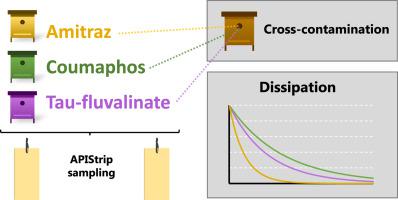Chemosphere ( IF 8.8 ) Pub Date : 2021-05-03 , DOI: 10.1016/j.chemosphere.2021.130783 María Murcia-Morales 1 , Francisco José Díaz-Galiano 1 , Inmaculada Guitérrez-Tirado 2 , José Manuel Flores 2 , Jozef J M Van der Steen 3 , Amadeo R Fernández-Alba 1

|
The active substances coumaphos, tau-fluvalinate and amitraz are among the most commonly employed synthetic miticides to control varroa infestations in apiculture. These compounds can persist inside the beehive matrices and can be detected long time after their application. The present study describes the application of a new passive sampling methodology to assess the dissipation of these miticides as well as the cross-contamination in neighboring beehives. The APIStrips are a recently developed sampling device based on the sorbent Tenax, which shows a remarkable versatility for the sorption of molecules onto its surface. This avoids the need of actively sampling apicultural matrices such as living bees, wax or reserves (honey and pollen), therefore allowing to obtain representative information of the contamination in the beehive environment in one single matrix. The results show that the amitraz-based treatments have the fastest dissipation rate (half-life of 11–14 days), whereas tau-fluvalinate and coumaphos remain inside the beehive environment for longer time periods, with a half-life up to 39 days. In the present study, tau-fluvalinate originated an intense cross-contamination, as opposed to coumaphos and amitraz. This study also demonstrates the contribution of drifting forager bees in the pesticide cross-contamination phenomena. Moreover, the sampling of adult living bees has been compared to the APIStrip-based sampling, and the experimental results show that the latter is more effective and consistent than traditional active sampling strategies. The active substances included in this study do not migrate to the honey from the treated colonies in significant amounts.
中文翻译:

养蜂业中杀螨剂的消散和交叉污染。通过基于APIStrip的采样进行评估
活性物质库马磷,tau-fluvalinate和阿米特拉斯是最常用的合成杀螨剂,可用于控制养蜂业中的varroa侵染。这些化合物可以保留在蜂巢基质中,使用后很长一段时间都可以被检测到。本研究描述了一种新的被动采样方法的应用,以评估这些杀螨剂的消散以及相邻蜂箱中的交叉污染。APIStrips是最近开发的一种基于吸附剂Tenax的采样设备,该设备显示了将分子吸附到其表面上的显着多功能性。这样就避免了主动取样养蜂基质(例如活蜂,蜡或保护区(蜂蜜和花粉))的需要,因此可以在一个单一的矩阵中获得蜂巢环境中污染物的代表性信息。结果表明,以阿米特拉斯为基础的处理具有最快的耗散率(半衰期为11-14天),而tau-fluvalinate和coumaphos在蜂巢环境中保留的时间更长,半衰期长达39天。 。在本研究中,tau-fluvalinate引发了强烈的交叉污染,这与库马磷和阿米特拉斯相反。这项研究还证明了流失的觅食蜂在农药交叉污染现象中的贡献。此外,已将成年活蜂的采样与基于APIStrip的采样进行了比较,实验结果表明,后者比传统的主动采样策略更有效,更一致。



























 京公网安备 11010802027423号
京公网安备 11010802027423号